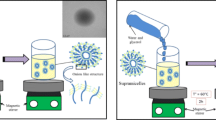Abstract
In this study, the effects of ethanol and/or diclofenac on vesicle bilayer structure have been studied. Liposomes with hydrogenated soy phosphatidylcholine, cholesterol and two different concentrations of diclofenac sodium (5 and 10 mg/ml) were obtained. In addition, ethanol was mixed in the water phase at different concentrations (5, 10 and 20 % v/v) to obtain ethosomes. To characterize vesicles, rehological analysis were carried out to investigate the intervesicle interactions, while bilayer structure was evaluated by small- and wide-angle X-ray scattering. Finally, the ethanol and/or diclofenac concentration-dependent ability to improve diclofenac skin delivery was evaluated in vitro. The addition of 20 % ethanol and/or diclofenac led to solid-like ethosome dispersion due to the formation of a new intervesicle structure, as previously found in transcutol containing vesicle dispersions. However, when using 5–10 % of ethanol the induction to form vesicle interconnections was less evident but the simultaneous presence of the drug at the highest concentration facilitated this phenomenon. Ethosomes containing the highest amount of both, drug (10 mg/ml) and ethanol (20 % v/v), improved the drug deposition in the skin strata and in the receptor fluid up to 1.5-fold, relative to liposomes. Moreover this solid-like formulation can easily overcome drawbacks of traditional liquid liposome formulations which undergo a substantial loss at the application site.




Similar content being viewed by others
References
Cevc G, Marsh D. Phospholipid bilayers: physical principles and models. Cell Biol. 1987.
Angelico R, Carboni M, Lampis S, Schmidt J, Talmon Y, Monduzzi M, et al. Physicochemical and rheological properties of a novel monoolein-based vesicle gel. Soft Matter. 2013;9:921.
Tavano L, Pinazo A, Abo-Riya M, Infante MR, Manresa MA, Muzzalupo R, et al. Cationic vesicles based on biocompatible diacyl glycerol-arginine surfactants: physicochemical properties, antimicrobial activity, encapsulation efficiency and drug release. Colloids Surf. B. Biointerfaces. 2014;120C:160–7.
Lian T, Ho RJ. Trends and developments in liposome drug delivery systems. J Pharm Sci. 2001;90:667–80.
Ainbinder D, Fresta M, Touitou EDP. Drug delivery applications with ethosomes. J Biomed Nanotechnol. 2010;6:558–68.
Castangia I, Nácher A, Caddeo C, Valenti D, Fadda AM, Díez-Sales O, et al. Fabrication of quercetin and curcumin bionanovesicles for the prevention and rapid regeneration of full-thickness skin defects on mice. Acta Biomater. 2014;10:1292–300.
Mehanna MM, Motawaa AM, Samaha MW. Nanovesicular carrier-mediated transdermal delivery of tadalafil: i-formulation and physicsochemical characterization. New York: Drug Dev. Ind. Pharm. Informa Healthcare USA, Inc.; 2014.
Gräbner D, Hoffmann H, Förster S, Rosenfeldt S, Linders J, Mayer C, et al. Hydrogels from phospholipid vesicles. Adv Colloid Interface Sci. 2014;208:252–63.
Castangia I, Manca ML, Matricardi P, Sinico C, Lampis S, Fernàndez-Busquets X, et al. Effect of diclofenac and glycol intercalation on structural assembly of phospholipid lamellar vesicles. Int J Pharm. 2013;456:1–9.
Manconi M, Mura S, Sinico C, Fadda AM, Vila AO, Molina F. Development and characterization of liposomes containing glycols as carriers for diclofenac. Colloids Surfaces A Physicochem Eng Asp. 2009;342:53–8.
Manca ML, Castangia I, Matricardi P, Lampis S, Fernàndez-Busquets X, Fadda AM, et al. Molecular arrangements and interconnected bilayer formation induced by alcohol or polyalcohol in phospholipid vesicles. Colloids Surfaces B Biointerfaces. 2014.
Manca ML, Zaru M, Manconi M, Lai F, Valenti D, Sinico C, et al. Glycerosomes: a new tool for effective dermal and transdermal drug delivery. Int J Pharm. 2013;455:66–74.
Simon SA, McIntosh TJ. Interdigitated hydrocarbon chain packing causes the biphasic transition behavior in lipid/alcohol suspensions. Biochim Biophys Acta. 1984;773:169–72.
McIntosh TJ, Lin H, Li S, Huang C. The effect of ethanol on the phase transition temperature and the phase structure of monounsaturated phosphatidylcholines. Biochim Biophys Acta Biomembr. 2001;1510:219–30.
Guazelli CFS, Fattori V, Colombo BB, Georgetti SR, Vicentini FTMC, Casagrande R, et al. Quercetin-loaded microcapsules ameliorate experimental colitis in mice by anti-inflammatory and antioxidant mechanisms. J Nat Prod. 2013;76:200–8.
Celia C, Cilurzo F, Trapasso E, Cosco D, Fresta M, Paolino D. Ethosomes® and transfersomes® containing linoleic acid: physicochemical and technological features of topical drug delivery carriers for the potential treatment of melasma disorders. Biomed Microdevices. 2012;14:119–30.
Chessa M, Caddeo C, Valenti D, Manconi M, Sinico C, Fadda AM. Effect of Penetration enhancer containing vesicles on the percutaneous delivery of quercetin through new born pig skin. Pharmaceutics. 2011;3:497–509.
El-Sousi S, Nácher A, Mura C, Catalán-Latorre A, Merino V, Merino-Sanjuán M, et al. Hydroxypropyl methylcellulose films for the ophthalmic delivery of diclofenac sodium. J Pharm Pharmacol. 2013;65:193–200.
Stewart JCM. Colorimetric determination of phospholipids with ammonium ferrothiocyanate. Anal Biochem. 1980;104:10–4.
Pabst G, Rappolt M, Amenitsch H, Laggner P. Structural information from multilamellar liposomes at full hydration: full q-range fitting with high quality X-ray data. Phys Rev E. 2000;62:4000–9.
Manca ML, Manconi M, Falchi AM, Castangia I, Valenti D, Lampis S, et al. Close-packed vesicles for diclofenac skin delivery and fibroblast targeting. Colloids Surf B Biointerfaces. 2013;111:609–17.
Haidar ZS, Hamdy RC, Tabrizian M. Protein release kinetics for core–shell hybrid nanoparticles based on the layer-by-layer assembly of alginate and chitosan on liposomes. Biomaterials. 2008;29:1207–15.
Manconi M, Caddeo C, Sinico C, Valenti D, Mostallino MC, Lampis S, et al. Penetration enhancer-containing vesicles: composition dependence of structural features and skin penetration ability. Eur J Pharm Biopharm. 2012;82:352–9.
Acknowledgments
Sardegna Ricerche Scientific Park (Pula, CA, Italy) is acknowledged for free access to facilities of the Nanobiotechnology Laboratory. This work was partially supported by MIUR Grants (PRIN 2010-2011, Prot. 2010H834LS_004) and a grant from the Ministerio de Economía y Competitividad, Spain (BIO2011-25039), which included FEDER funds, and by a grant from the Generalitat de Catalunya, Spain (2009SGR-760).
Author information
Authors and Affiliations
Corresponding author
Rights and permissions
About this article
Cite this article
Castangia, I., Manca, M.L., Matricardi, P. et al. Effects of ethanol and diclofenac on the organization of hydrogenated phosphatidylcholine bilayer vesicles and their ability as skin carriers. J Mater Sci: Mater Med 26, 137 (2015). https://doi.org/10.1007/s10856-015-5443-1
Received:
Accepted:
Published:
DOI: https://doi.org/10.1007/s10856-015-5443-1




